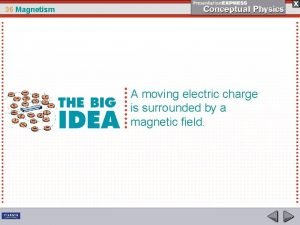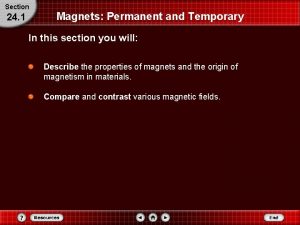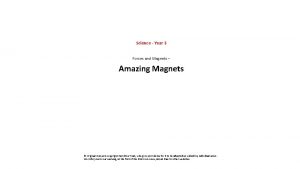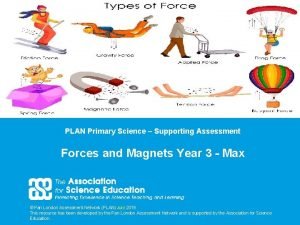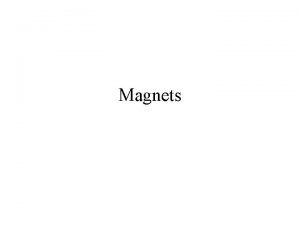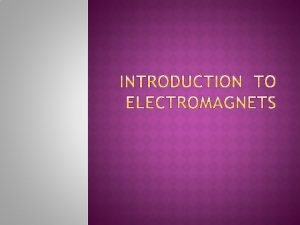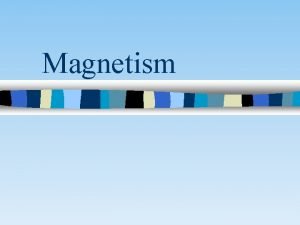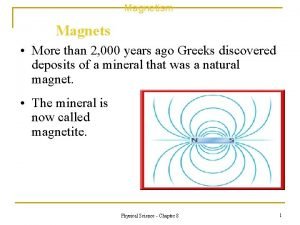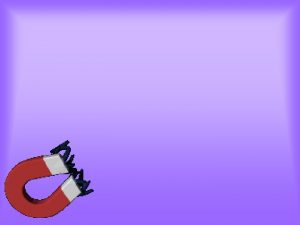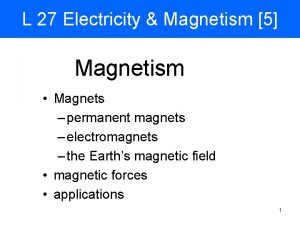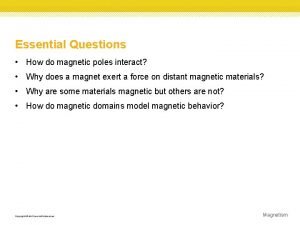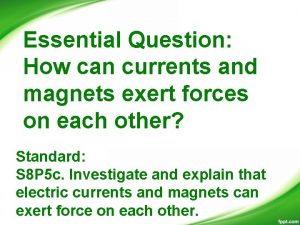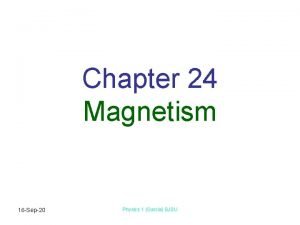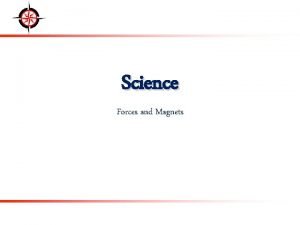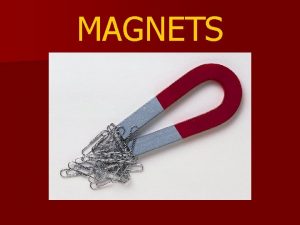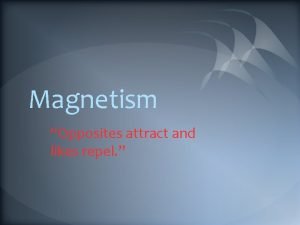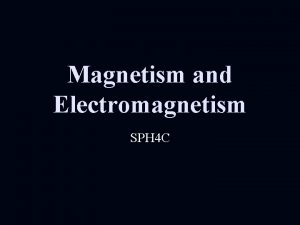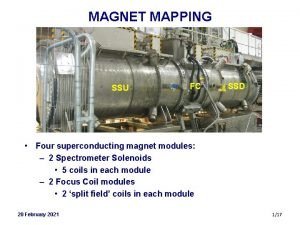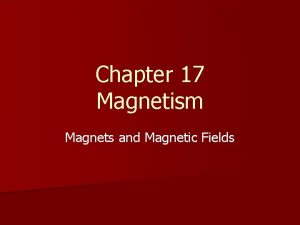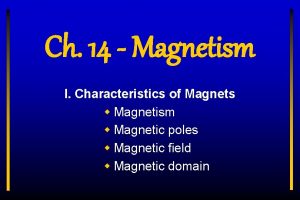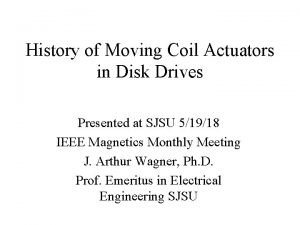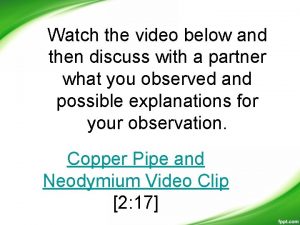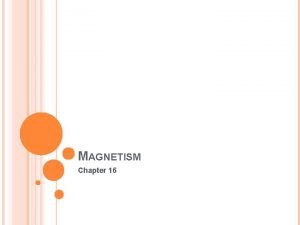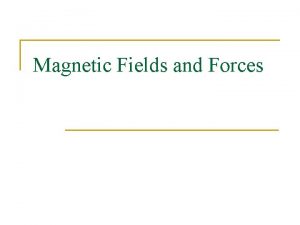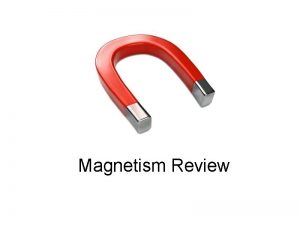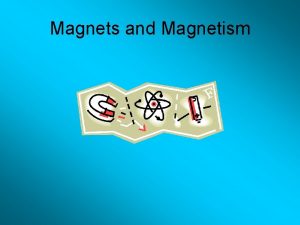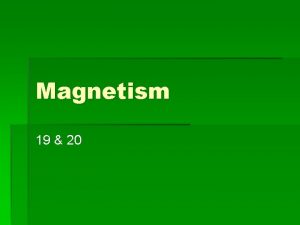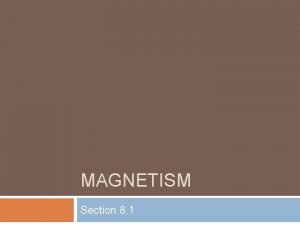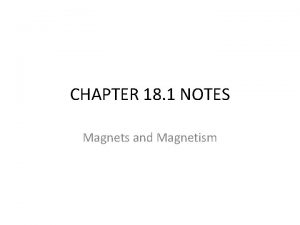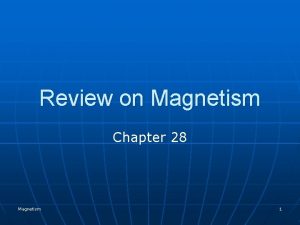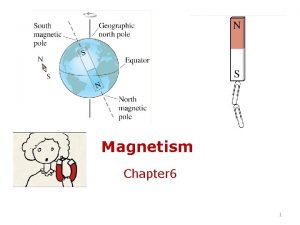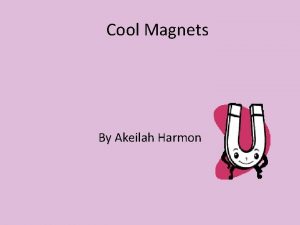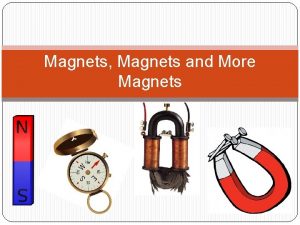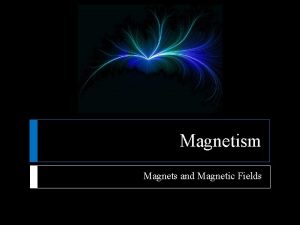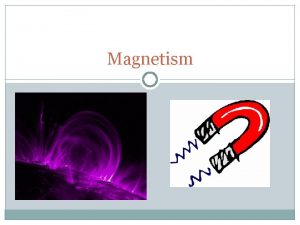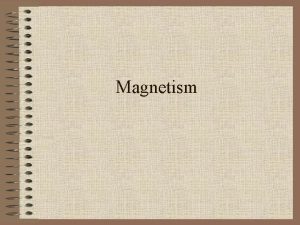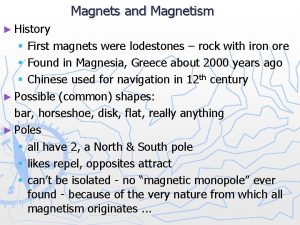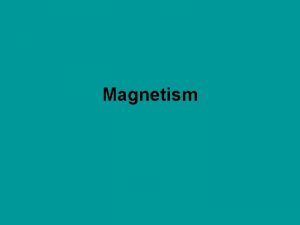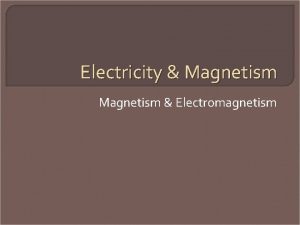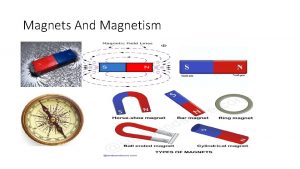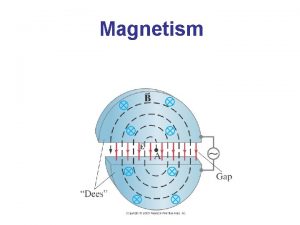Magnetism Chapter 22 Properties Of Magnets 22 1





































- Slides: 37

Magnetism Chapter 22

Properties Of Magnets 22. 1

Magnetism Magnetic material has the ability to exert forces on other magnetic material Permanent Magnets retain magnetic properties and have North and South Poles (are considered Dipolar) � LIKE POLES REPEL � OPPOSITE POLES ATTRACT

Magnets �Magnetic poles cannot be isolated �If a permanent magnetic is cut in half repeatedly, you will still have a north and a south pole �This differs from electric charges �There is some theoretical basis for monopoles, but none have been detected

More About Magnetism �An unmagnetized piece of iron can be magnetized by stroking it with a magnet �Somewhat like stroking an object to charge an object �Magnetism can be induced �If a piece of iron, for example, is placed near a strong permanent magnet, it will become magnetized

Magnetic Forces �Pass through materials like electric forces. �Are easier to create than electric force �Are weaker than electric forces �Related by an inverse exponent law but more so than electric forces �Torque is created between any two dipolar magnets.

Magnetic Fields �Exist around any magnet and exert forces on other magnets and magnetic materials along the Field Lines. �A vector quantity �Symbolized by or B �Direction is given by the direction a north pole of a compass needle points in that location �Magnetic field lines can be used to show the field lines, as traced out by a compass, would look �The Density or Flux of these lines indicate the strength of the magnetic field at any given point.

Magnetic Field Lines, sketch �A compass can be used to show the direction of the magnetic field lines (a) �Field extends out from the north pole and into the south pole �A sketch of the magnetic field lines (b)

Magnetic Field Lines, Bar Magnet �Iron filings are used to show the pattern of the magnetic field lines �The direction of the field is the direction a north pole would point

Magnetic Field Lines, Unlike Poles �Iron filings are used to show the pattern of the magnetic field lines �The direction of the field is the direction a north pole would point �Compare to the magnetic field produced by an electric dipole

Magnetic Field Lines, Like Poles �Iron filings are used to show the pattern of the electric field lines �The direction of the field is the direction a north pole would point �Compare to the electric field produced by like charges

Magnetic Properties of Materials 22. 2

Units of Magnetic Field �The SI unit of magnetic field is the Tesla (T) �Wb is a Weber �The cgs unit is a Gauss (G) � 1 T = 104 G

A Few Typical B Values �Conventional laboratory magnets � 25000 G or 2. 5 T �Superconducting magnets � 300000 G or 30 T �Earth’s magnetic field � 0. 5 G or 5 x 10 -5 T

Sources of Magnetic Fields �The region of space surrounding a moving charge includes a magnetic field �The charge will also be surrounded by an electric field �A magnetic field surrounds a properly magnetized magnetic material �Electrons orbiting atomic nuclei (moving charges) give each atom a magnetic field; these fields can align to varying degrees within a material

Magnetic Effects of Electrons – Orbits �An individual atom should act like a magnet because of the motion of the electrons about the nucleus �Each electron circles the atom once in about every 10 -16 seconds �This would produce a current of 1. 6 m. A and a magnetic field of about 20 T at the center of the circular path �However, the magnetic field produced by one electron in an atom is often canceled by an oppositely revolving electron in the same atom

Magnetic Effects of Electrons – Orbits �The net result is that the magnetic effect produced by electrons orbiting the nucleus is either zero or very small for most materials

Magnetic Effects of Electrons – Spins �Electrons also have spin �The classical model is to consider the electrons to spin like tops �It is actually a quantum effect

Magnetic Effects of Electrons – Spins �The field due to the spinning is generally stronger than the field due to the orbital motion �Electrons usually pair up with their spins opposite each other, so their fields cancel each other �That is why most materials are not naturally magnetic

Types of Magnetic Materials �Diamagnetic – very weak or no magnetism. Atoms arranged in such a way that each one’s magnetic field is effectively cancelled out by the others �Paramagnetic – slightly magnetic. Some of the atoms provide magnetic fields but not very strong (intermediate material). �Ferromagnetic – contain Magnetic Domains which are strongly aligned North or South-oriented. Thus, they are attracted to EITHER pole of a magnet

Diamagnetic Materials �In diamagnetic materials, an externally applied magnetic field induces a weak magnetization that is opposite to the applied field, thus causing a repulsive effect. Materials include copper, silver and gold.

Paramagnetic Materials �Paramagnetic materials have magnetic moments that tend to align with an externally applied magnetic field but the response is weak compared to ferromagnetic materials. �These properties are due to the presence of some unpaired electrons, and from the realignment of the electron orbits caused by the external magnetic field. �Paramagnetic materials include aluminum, oxygen and sodium.

Ferromagnetic Materials �Ferromagnetic materials have a permanent magnetic moment. If a small external magnetic field is applied, the magnetic domains line up together and the material is magnetized. Materials include iron, nickel and cobalt. These substances can retain some of their magnetization even after the applied magnetic field is removed.

Magnetic Effects of Electrons – Domains �In some materials, the spins do not naturally cancel �Such materials are called ferromagnetic �Large groups of atoms in which the spins are aligned are called domains �When an external field is applied, the domains that are aligned with the field tend to grow at the expense of the others �This causes the material to become magnetized

Domains �Random alignment, a, shows an unmagnetized material �When an external field is applied, the domains aligned with B grow, b (a) (b)

Types of ferromagnetic Materials �Soft magnetic materials, such as iron, are easily magnetized �They also tend to lose their magnetism easily �Hard magnetic materials, such as cobalt and nickel, are difficult to magnetize �They tend to retain their magnetism �Permeability (μ) – is the ability of a FM material to concentrate B lines within it.

The Magnetic Field of the Earth 22. 3

History of Orienteering � 500 B. C. – Lodestones (magnetite) – the Greeks discover magnetic properties of rocks � 220 B. C. – Zheng Dynasty records refer to a “south pointer, ” a device used for navigation � 1088 A. D. – Chinese first use compasses during the Sung Dynasty in exploration � 13 th Century – Europeans begin using compasses � 15 th Century – Chinese fleets use compasses to (possibly) circumnavigate the globe (see “ 1421” and “ 1434” by Gavin Menzies)

Compass �A magnetized, free-floating needle which aligns itself with Earth’s magnetic field lines. �Points toward the North pole because this is where the field lines enter. �Points to MAGNETIC North, NOT GEOGRAPHIC North

Earth’s Magnetic Field �The Earth’s geographic north pole corresponds to a magnetic south pole �The Earth’s geographic south pole corresponds to a magnetic north pole �Strictly speaking, a north pole should be a “north-seeking” pole and a south pole a “south-seeking” pole �Strength of the Earth’s Magnetic Field is measured in Gauss

Source of the Earth’s Magnetic Field �There cannot be large masses of permanently magnetized materials since the high temperatures of the core prevent materials from retaining permanent magnetization �The most likely source of the Earth’s magnetic field is believed to be electric currents in the liquid part of the core

Reversals of the Earth’s Magnetic Field �The direction of the Earth’s magnetic field reverses every few million years �Evidence of these reversals are found in basalts resulting from volcanic activity �The origin of the reversals is not understood

Earth’s Magnetic Field �The Earth’s magnetic field resembles that achieved by burying a huge bar magnet deep in the Earth’s interior

More About the Earth’s Magnetic Poles �The dip angle of 90° is found at a point just north of Hudson Bay in Canada �This is considered to be the location of the north magnetic pole �The magnetic and geographic poles are not in the same exact location �The difference between true north, at the geographic north pole, and magnetic north is called the magnetic declination � The amount of declination varies by location on the earth’s surface

Earth’s Magnetic Declination

Inclination of Earth’s Magnetic Field �If a compass is free to rotate vertically as well as horizontally, it points to the earth’s surface �The angle between the horizontal and the direction of the magnetic field is called the inclination �The farther north the device is moved, the farther from horizontal the compass needle would be The compass needle would be horizontal at the equator and the dip angle would be 0° � The compass needle would point straight down at the south magnetic pole and the dip angle would be 90° �

Inclination of Earth’s Magnetic Field
 Properties and interactions of magnets
Properties and interactions of magnets Conceptual physics magnetism
Conceptual physics magnetism Magnetism
Magnetism Magnets for year 3
Magnets for year 3 Magnets and springs
Magnets and springs What happens if you break a magnet in half
What happens if you break a magnet in half Amazing magnets fishing magnet
Amazing magnets fishing magnet Why do magnets repel
Why do magnets repel Magnets for neutron diffraction
Magnets for neutron diffraction Amazing magnets
Amazing magnets Why do magnets repel
Why do magnets repel Temporary vs permanent magnets
Temporary vs permanent magnets Gmx magnets
Gmx magnets Natural magnets examples
Natural magnets examples Why do magnets repel
Why do magnets repel Oh magnets electromagnet
Oh magnets electromagnet Has an invisible force that pulls the metals to it
Has an invisible force that pulls the metals to it Bbc bitesize electric bell
Bbc bitesize electric bell Scrap heap magnet circuit diagram
Scrap heap magnet circuit diagram How are permanent magnets formed
How are permanent magnets formed How do magnetic poles interact
How do magnetic poles interact Explain how currents and magnets exert forces on each other
Explain how currents and magnets exert forces on each other Mr garcia uses magnets
Mr garcia uses magnets Amazing magnets
Amazing magnets Properties of magnet
Properties of magnet What are magnets
What are magnets With magnets likes repel and opposites
With magnets likes repel and opposites Amazing magnets
Amazing magnets Ssd and magnets
Ssd and magnets Force exerted by magnets
Force exerted by magnets Characteristics of magnetism
Characteristics of magnetism Hard drive actuator motor magnets
Hard drive actuator motor magnets Electromagnet in speakers
Electromagnet in speakers Sigmaphi electronics haguenau
Sigmaphi electronics haguenau Which diagram shows magnets that will attract each other?
Which diagram shows magnets that will attract each other? Horseshoe magnets home depot
Horseshoe magnets home depot What is magnet and magnetism
What is magnet and magnetism Magnetismn
Magnetismn


